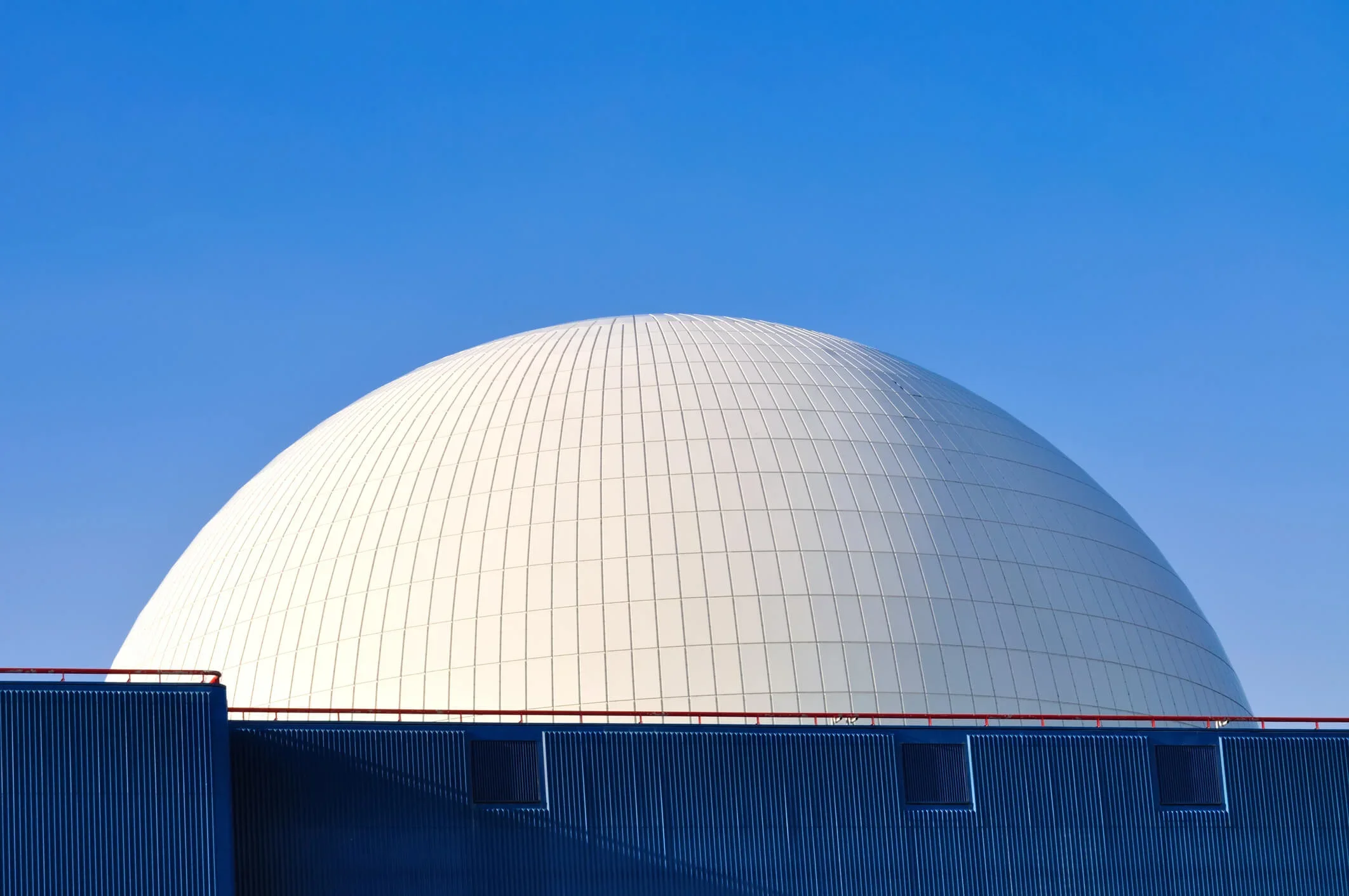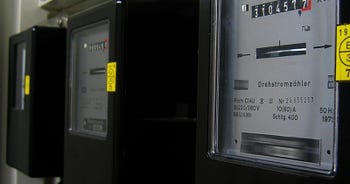The Regulated Asset Base (RAB) nuclear levy: What every small business needs to know
Nuclear energy production is essential for the UK’s future energy security and to help meet net-zero climate targets by 2050. But nuclear power plants aren’t cheap.
To help fund future nuclear projects, the government has introduced the Regulated Asset Base (RAB) nuclear levy.
The good news is that diversifying the UK’s energy mix and reducing its reliance on imports will help avoid future price shocks, such as the one we saw in 2022. The bad news is that we all need to pay more for our energy.
Whether you run a small corner shop or a massive chemical production plant, here’s all you need to know about the RAB levy and how it could affect your business.

Five-point summary
- The RAB nuclear levy is a new government charge that funds the construction of future nuclear power stations — starting with Sizewell C in Suffolk — as part of the UK’s strategy for long-term energy security and achieving net zero by 2050.
- All homes and businesses connected to the UK electricity grid will pay the levy through their electricity bills. Only Energy Intensive Industries (EIIs) with official exemption certificates will be exempt.
- The levy takes effect from November 1, 2025, appearing as a separate “non-commodity” or “third-party” charge on bills. Suppliers must include it for all eligible customers.
- The initial rate is set at £3.455 per MWh (around 0.35p per kWh). This means a typical small business using 10,000 kWh per year will pay about £35 extra annually, while larger users will pay proportionally more based on consumption.
- Though it raises short-term costs, the RAB levy supports domestic, low-carbon nuclear generation — reducing reliance on imported gas and helping stabilise future energy prices, benefiting both businesses and consumers in the long run.
What is the RAB (Regulated Asset Base) nuclear levy?
The RAB (Regulated Asset Base) nuclear levy is a new charge that will appear on both domestic and business electricity bills in the UK. The government introduced this levy to help raise money for building new nuclear power stations (such as Sizewell C in Suffolk) by guaranteeing funding for developers through a regulated, long-term charge.
Is the RAB levy compulsory for homes and businesses?
Yes, the RAB nuclear levy applies to all homes and businesses in the UK. If you have a standard electricity supply, whether you’re a small shop, office, or factory, you will pay this charge. It’s a mandatory non-commodity cost added to all electricity bills.
Are there any exemptions from the RAB nuclear levy?
The main exception to the Nuclear RAB levy is for businesses with an Energy Intensive Industries (EII) exemption
At present, there are no general exemptions for typical small businesses or households. Special cases (for instance, some off-grid properties or businesses with private power arrangements) might not see the charge, but almost every standard gas or electricity customer will pay it.
When will the RAB nuclear levy start appearing on energy bills?
The RAB nuclear levy is scheduled to start appearing on bills by December 2025, but some energy suppliers have already started applying the charge.
It should appear as a separate ‘non-commodity’ charge, alongside things like the Renewables Obligation (RO) and Feed-in Tariff/Smart Export Guarantee.
How much will the RAB nuclear Levy cost for your business?
For business electricity bills, the RAB nuclear levy is estimated to add about 0.35p per kWh of electricity used. If your business uses 10,000 kWh per year, you’ll pay around £35 extra annually because of this levy.
The way the RAB (Regulated Asset Base) nuclear levy impacts businesses depends on your organisation's size, energy use, and industry sector. Here’s how it could affect different types of businesses:
Small and micro businesses
- Most small and micro businesses, such as high street shops, cafes, offices, or small warehouses, will see only a modest increase in their electricity bills because the charge is based on the amount of energy they use.
- For example, the increase amounts to about 0.35p per kWh. For a business that uses 10,000 kWh a year, this means roughly £35 extra per year.
- The increase will show as an extra line or in the non-commodity cost section of your energy bill.
| Business type | Annual usage | Annual RAB payment |
| Hairdresser/Barber | 40,000 kWh | £140.00 |
| Cafe/Coffee Shop | 19,000 kWh | £66.50 |
| Newsagent | 11,000 kWh | £38.50 |
| Small Office | 10,000 kWh | £35.00 |
These businesses typically have lower energy usage and will pay a modest additional amount (around £35 extra per year for a business using 10,000 kWh).
Charities and non-profits are not exempt from the Nuclear RAB (Regulated Asset Base) levy and will need to pay based on the amount of electricity they use.
Medium and large businesses
- Larger businesses with higher energy usage (like supermarkets, hotels, or mid-sized manufacturers) will see the cost scale up - the more electricity your business consumes, the higher your total RAB charge will be.
- Large electricity users that do not qualify for exemption could see a big increase in annual costs. This makes it important for them to monitor contract terms and energy efficiency strategies.
- Businesses on fixed contracts may see the levy added at renewal or sooner if their contract terms allow for government charges to be passed through.
Examples include:
| Business type | Annual usage | Annual RAB payment |
| Supermarket | 1,130,000 kWh | £3,904 |
| Leisure Centre | 125,000 kWh | £432 |
These organisations use more electricity, so the total levy cost will be much greater—possibly hundreds or thousands of pounds extra per year, depending on their kWh usage.
Energy Intensive Industries (EIIs)
- Certain sectors classified as Energy Intensive Industries (like steel, chemicals, glass, and other heavy manufacturing) can be exempt from the RAB levy if they meet both sector-level and business-level criteria and hold the required certification.
- For these businesses, there will be no RAB levy added to their bill, which helps protect their international competitiveness.
Examples of sectors or specific types of businesses eligible for exemption:
- Steelworks (e.g., British Steel)
- Chemical production plants (e.g., Ineos facilities)
- Glass manufacturers (e.g., Pilkington UK)
- Paper mills or pulp manufacturers
These firms can be exempt if they pass both sector and business-level energy intensity tests and have the required certification. Visit the government website to apply for exemption.
All other non-domestic energy users
Nearly all UK non-domestic electricity customers who are not classed as EIIs will pay the levy, regardless of sector or location. The only exception is if a supplier chooses to absorb the cost (rare for most contracts), or in cases where further government support is announced in response to economic pressures.
What is the RAB levy funding?
The money raised from the RAB nuclear levy goes directly towards funding the development and construction of new nuclear power stations in the UK.
These stations provide low-carbon electricity and support national energy security, with the first major project being Sizewell C in Suffolk.
How long will businesses need to pay the RAB nuclear levy?
The charge is expected to run for as long as the RAB funding model is needed - technically for the entire construction and early operational life of the new nuclear facilities. This could mean several decades, although the exact timeline can change depending on policy and the progress of ongoing projects.
How will the RAB nuclear levy appear on electricity bills?
From November 2025, you’ll see the RAB nuclear levy listed as a line item or included in the "non-commodity" or "third party" charges section of your electricity bill. Your supplier should make this clear in the breakdown of charges on the bill. Check out our guide to business energy bills to see what information usually appears on gas and electricity bills.
If you aren’t sure where the charge is shown, ask your supplier to point it out or explain it with your usual energy costs.
What are non-commodity costs on an energy bill?
Non-commodity costs are typically costs that originate from a third-party, which are then passed on to your energy supplier, and finally, are passed down to you in your bills.
Some examples of non-commodity costs include:
- Network charges - Costs for transporting, distributing, and maintaining electricity and gas networks (transmission and distribution charges).
- Environmental and policy levies - Government initiatives such as support for renewables (e.g., Contracts for Difference, Renewables Obligation, Feed-in Tariff), and decarbonisation and energy efficiency schemes (such as the Climate Change Levy).
- System balancing - Charges ensuring supply and demand are balanced, and there is reliable capacity, including costs like the Capacity Market Charge.
- Industry regulation - Charges related to running the market, compliance, settlement systems, and consumer protection.
Does the RAB levy vary by energy usage or business size?
The RAB nuclear levy is charged per kWh, so the more electricity you use, the higher your levy payment. Although the rate is flat, larger businesses and heavier users that aren’t exempt will pay more than lower-usage businesses.
How to prepare your business for the RAB Nuclear levy in 2025
The RAB levy is unavoidable for most businesses and is directly linked to your actual electricity usage. Only those qualifying as EIIs with official exemption certificates can avoid this cost; for everyone else—from shops to schools, offices to factories—it will become a standard part of energy bills from December 2025.
If you want to plan for business energy costs in 2025 and beyond, consider factoring this levy into your annual electricity budget and keep an eye out for supplier communications.
RAB nuclear levy FAQs
Here’s an at-a-glance guide to some of the most frequently asked questions about the RAB levy:
When will the RAB nuclear levy start appearing on bills?
The RAB nuclear levy may already be showing on your bill, but it will begin appearing on all UK electricity bills from November or December 2025, depending on final implementation dates.
How much will the levy cost?
The initial charge is around 0.35p per kWh of electricity used. The total cost to you will depend on your individual consumption.
Who has to pay the levy?
The levy is a compulsory charge for nearly all UK homes and businesses. Exemptions are very limited, primarily affecting certain Energy Intensive Industries with special certificates.
What is the purpose of the levy?
Money collected will help fund new nuclear projects, like Sizewell C, with the goal of creating a more reliable and low-carbon electricity supply for the UK.
How long will the levy be in place?
The RAB nuclear levy is expected to remain on bills for decades, funding the construction and operation of new nuclear power stations for as long as it is needed.
How do I identify the charge on my bill?
After November 2025, look for a line called "RAB nuclear levy" or "nuclear funding levy" in the non-commodity charges section of your electricity bill.
Will the prices quoted by an energy broker include the RAB nuclear levy?
At Bionic, we’ve worked with our panel of business energy suppliers to understand whether the RAB levy will be included in the prices you’re quoted. But not all suppliers include this charge, so it’s always worth checking whether it’s part of your quote before agreeing to fix your rates."








